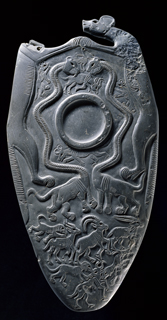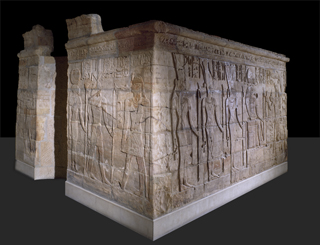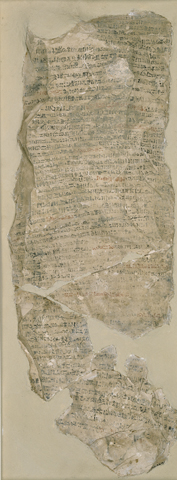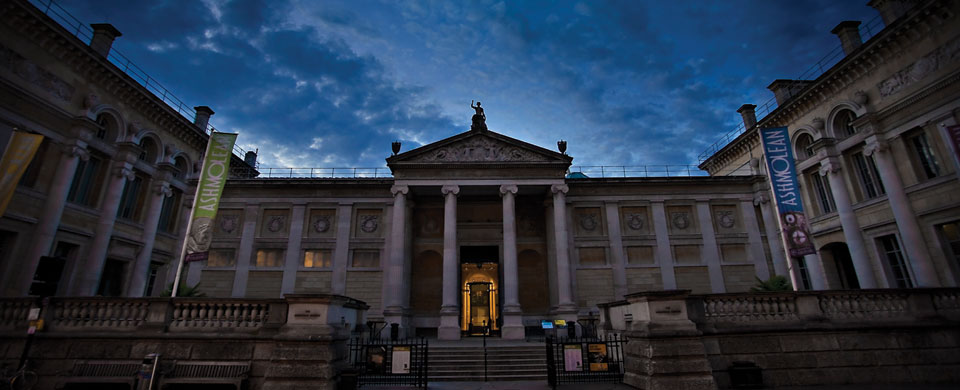Department of Antiquities

The 'Two Dog' palette,
Hierakonpolis, 'Main Deposit',
Late Predynastic–Early
Dynastic (about 3300–3100 BC),
Egyptian Research Account
excavations. AN1896-1908E.3924
Ancient Egypt and Sudan
The Ashmolean's collections from ancient Egypt and Sudan are among the most extensive in Britain, with approximately 50,000 objects representing every period of human occupation in the Nile Valley from prehistory to the 7th century AD.
The first Egyptian objects arrived in the Museum in 1683 – the year of its foundation – but the major holdings derive from British excavations in Egypt conducted from the 1880s until the late 1930s (for a complete list of sites represented in the collections, see here). Oxford University excavations in southern Egypt and Sudan from 1910 onward (directed and largely funded by Francis Llewellyn Griffith, the first Professor of Egytplogy at Oxford) added a representative collection of Nubian material (for a list of sites, see here).
Among the most significant groups of material are the objects of Predynastic and Early Dynastic date (about 5000–2650 BC) from excavations at Naqada, Abydos, Koptos, and Hierakonpolis. These include such masterpieces as the 'Two Dog' palette, the Scorpion and Narmer mace-heads, and a limestone statue of King Khasekhem (2nd Dynasty, about 2700–2686 BC).
The museum's extensive collection of funerary material includes the finest set of coffins from a group belonging to a family burial of Theban priests of the 25th Dynasty (about 770–713 BC) found within the temple of Queen Hatshepsut at Deir el-Bahri. These were discovered by the first archaeologist to work for the Egypt Exploration Fund, Edouard Naville.
From excavations at Tell el-Amarna, the capital of the so-called 'heretic king' Akhenaten (New Kingdom, 18th Dynasty, about 1353–1335 BC), came many pieces of sculpture, objects of daily life, and fragmentary paintings, of which the 'Princesses fresco' is the best known.

Shrine of King Taharqa, Kawa, Sudan, Late Period/Napatan,
25th Dynasty (about 690–664 BC),Given by Mrs Nora Griffith,
in memory of Prof. Francis Llewellyn Griffith, AN1936.661
Professor Griffith's excavations in Nubia brought to Oxford a representative collection of material from this region (the area now comprising southern Egypt and northern Sudan). It includes the largest object in the museum – the Shrine of King Taharqa (25th Dynasty, about 690–664 BC) – the only free-standing pharaonic monument in Britain.
Many of the donations and bequests which have enriched the collections are associated with famous Egyptologists and Oxford scholars. From Sir Alan Gardiner, the greatest twentieth-century English scholar of the ancient Egyptian language, came documents on papyrus, such as the 'Will of Naunakhte' (about 1145 BC).

The 'Sinuhe Ostracon'. Probably from
Deir el-Medina, New Kingdom,
19th Dynasty (about 1292'1190 BC),
Given by Sir Alan Gardiner,
AN1945.40
In addition to papyri, the Ashmolean houses over 8,000 ostraca, inscribed fragments of pottery or limestone which served as a cheap writing medium in the ancient world. These include the Gardiner collection of hieratic ostraca, most notably the 'Sinuhe Ostracon' (the largest surviving limestone ostracon from ancient Egypt, inscribed with a copy of the literary classic, 'The Tale of Sinuhe') as well as the Bodleian Library's collections of writing boards, wooden labels, and ostraca. Together they provide examples of all the scripts and languages that have been used in Egypt (Egyptian, Greek, Coptic, Aramaic, and Arabic), with documents ranging from school texts to private letters.
For more information relating to the collections, please contact Liam McNamara, Assistant Keeper for Ancient Egypt and Sudan liam.mcnamara@ashmus.ox.ac.uk.
Further reading
- P. Collins and L. McNamara, Ancient Egypt and Nubia at the Ashmolean, Gallery Guide (2011)
- P.R.S. Moorey, Ancient Egypt (2nd rev. edn 1988)
- J.C. Payne, Catalogue of the Predynastic Egyptian Collection in the Ashmolean Museum (1993, reprinted with addenda 2000)
- A. MacGregor, The Ashmolean Museum. A Brief History of its Collections (2001)
- H. Whitehouse, Ancient Egypt and Nubia in the Ashmolean Museum (2009)
Image: The 'Sinuhe Ostracon'. Probably from Deir el-Medina, New Kingdom, 19th Dynasty (about 1292–1190 BC), Given by Sir Alan Gardiner,
AN1945.40

